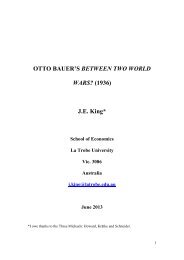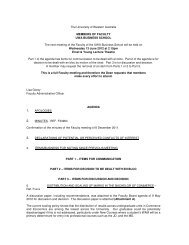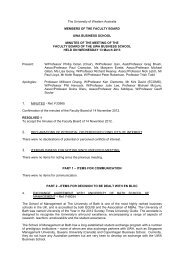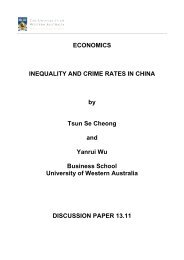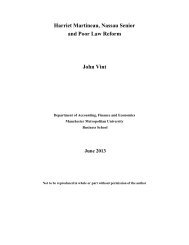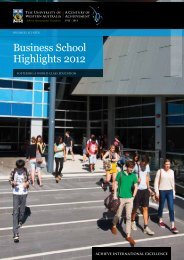A Dynamic Model for determining Inward Foreign ... - Business School
A Dynamic Model for determining Inward Foreign ... - Business School
A Dynamic Model for determining Inward Foreign ... - Business School
Create successful ePaper yourself
Turn your PDF publications into a flip-book with our unique Google optimized e-Paper software.
uncorrelated and normally distributed and that their variances do not vary with the effects<br />
being modelled. There<strong>for</strong>e, the White test was applied to detect whether the errors are<br />
heteroskedasticity or homoskedasticity<br />
( ) (<br />
Where<br />
The ARCH (1) model indicates that when a big shock happens in period , it is<br />
more likely that the value of will be bigger as well. This is, when is large or small,<br />
the variance of the next error term is also large or small. The estimated coefficient of<br />
has to be positive <strong>for</strong> positive variance. The ARCH model implanted in E-view in the mean<br />
and variance equations where stated above respectively. The results of ARCH show that the<br />
model is stable.<br />
3.3.2 Lagged <strong>Model</strong> Specification<br />
In the second stage the lagged model is introduced to explore the dynamic behaviour of<br />
Jordanian country risk (financial, economic and political risk), stock market price (banking,<br />
industry, services and general sectors) and macroeconomic factors (inflation, interest rate<br />
and GDP). Testing <strong>for</strong> long and short run relationships the following dynamic methods are<br />
implemented: firstly, vector autoregressive (VAR) model, Granger causality, Johansen’s<br />
Co-integration test and Error Correction <strong>Model</strong>.<br />
3.3.2.1 Vector Autoregressive model<br />
VAR model has the advantage of treating each variable under the study as an endogenous<br />
variable when economic theory cannot offer a priori in<strong>for</strong>mation regarding the variables<br />
used in the VAR. This makes VAR estimation simple and OLS estimation method can be<br />
used provided all variables included in the VAR are integrated of the same order Gujarati<br />
(1995 749). In this case, the time series is affected by current and past values of ,<br />
simultaneously, as well as the time series is a series affected by current and past values<br />
of the series. There<strong>for</strong>e, the following simple bivariate VAR model is considered<br />
(Brooks 2008 290, 291)<br />
( )<br />
( )<br />
15




